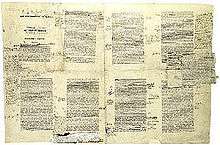Galley proof


In printing and publishing, proofs are the preliminary versions of publications meant for review by authors, editors, and proofreaders, often with extra-wide margins. Galley proofs may be uncut and unbound, or in some cases electronically published. They are created for proofreading and copyediting purposes, but may be used for promotional and review purposes also.[1][2][3]
Galley proofs are so named because in the days of hand-set letterpress printing, the printer would set the page into galleys—the metal trays into which type was laid and tightened into place—which would then be used to print limited copies for proofreading. The printer would then receive the edits, re-arrange the type, and print the final copy.
Some publishers use paper galley proofs as advance copies, providing them to reviewers, magazines, and libraries in advance of final publication; these print-on-demand (POD) pre-publication publicity proofs are normally bound, but may be lacking illustrations (or have them in black and white only). Proofs in electronic form are rarely offered for advance reading.
Proofs issued in the proofreading and copy-editing review phase are called galleys or galley proofs; proofs created in a near-final version for editing and checking purposes are called page proofs. In the page-proof stage, mistakes are supposed to have been corrected; to correct a mistake at this stage is expensive, and authors are discouraged from making many changes to page proofs. Page layouts are examined closely in the page proof stage. Page proofs also have the final pagination, which facilitates compiling the index.
These days, as paper and digital forms share the final product that readers actually use, the term uncorrected proof is more common as a term than galley proof, which refers exclusively to a paper proof version. Uncorrected proof describes the penultimate proof version (on paper or in digital form) yet to receive final author and publisher approval, the term appearing on the covers of advance reading copies (ARCs).
See also
References
- ↑ Allena Tapia. "Galley - What Is a Galley". About. Retrieved 20 November 2014.
- ↑ "Galley proof". TheFreeDictionary.com. Retrieved 20 November 2014.
- ↑ "Galley Proofs". Tailrecursive.org. Retrieved 20 November 2014.